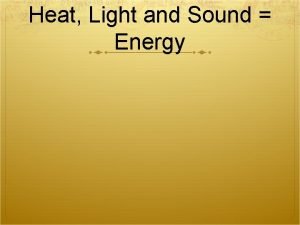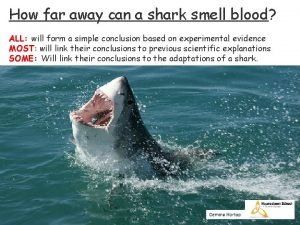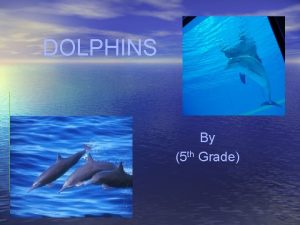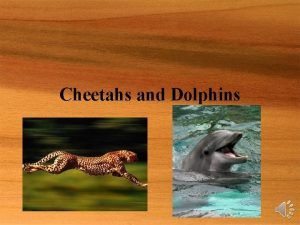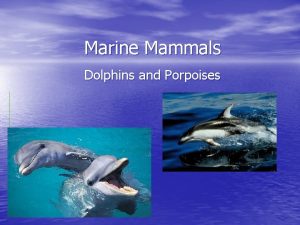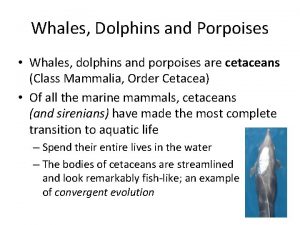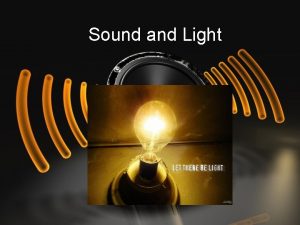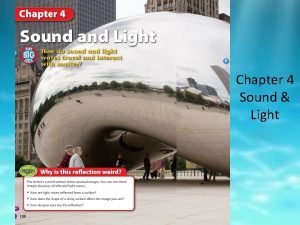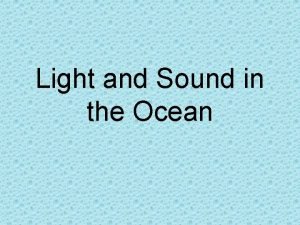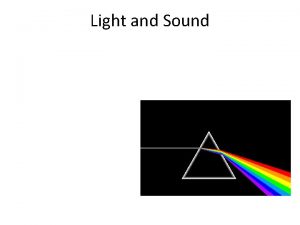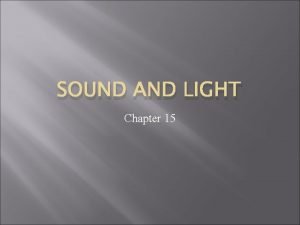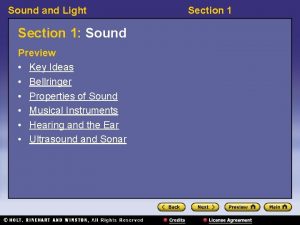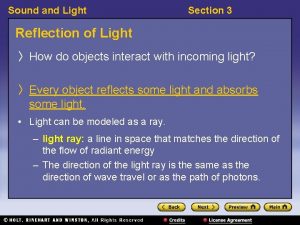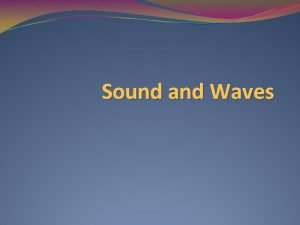Section 3 Sound and Light How do dolphins


























- Slides: 26

Section 3: Sound and Light How do dolphins detect objects in murky water?

Sound waves are produced by compression and rarefaction of vibrating objects: Compression: forward movement. Creates regions of high density Rarefaction: backward movement. Creates region of low density.

Sound and Us: We hear frequencies from 20 to 20, 000 Hz • Below 20 Hz is infrasonic • Above 20, 000 Hz is ultrasonic

Speed of sound in various objects: Higher density objects tend to have a higher speed of sound.

Parts of a sound Wave: 1) Wave front: area of compression 2) Wave length: distance from one compression to the next 3) Ray: Arrow indicating the direction of wave

Doppler Effect: Q: Does the speed of a sound wave depend on the pitch or frequency? Q: What will happens to the distance between the waves in front of the source as it moves forward? How about behind? Results: Check the following web site http: //landau 1. phys. virginia. edu/classes/109 N/more_stuff/flashlets/doppler. htm

Doppler effect continue… • Waves in front of source become closer because waves cannot get away. • Waves in back of source get longer. • Shock waves are produced when source is traveling faster than speed of sound








Resonance: Natural frequency: Frequency an object vibrates at. Swing/desk/ jar/ guitar/ • • Demo: Music Demo: Spring Demo: Tacoma bridge Demo: Electric guitar and wine glass How to break a tree Designing cars Designing engines


Standing wave in pipes open at both ends: Node: Regions of high and low compression that form within a pipe. Anti-node: Regions where the pressure remain unchanged. Fundamental frequency: natural frequency of pipe. Longer pipes have lower frequencies.

Fn = n v / (4 L) Fn: fundamental frequency or frequency of pipe (hz) n: number of nodes L: length of pipe v: speed of sound wave (343 m/s for air)

Problem: Find the frequency given off by a 2. 03 meter pipe, for nodes 1 through 3. Frequency Nodes Frequency

Light: Has alternating electric and magnetic fields and travels at 3 x 108 m/s.

Electromagnetic Spectrum: Range of all of the frequencies of light.

Visible Spectrum: Range of visible frequencies of light

More properties of waves: Refraction: The bending of light as it passes from one medium to the other

Diffraction: The bending of a wave around an object.


Polarization: When all of the directions of the light waves are aligned.
 How do dolphins use sound waves
How do dolphins use sound waves Light light light chapter 23
Light light light chapter 23 Light light light chapter 22
Light light light chapter 22 Light light light chapter 22
Light light light chapter 22 The higher the amplitude, the _______the sound.
The higher the amplitude, the _______the sound. Light is electromagnetic radiation true or false
Light is electromagnetic radiation true or false How does sound travel
How does sound travel Facts about light and sound
Facts about light and sound What is sound energy grade 4
What is sound energy grade 4 “a sound mind is in a sound body”
“a sound mind is in a sound body” Put out the light, and then put out the light
Put out the light, and then put out the light Bacteria double membrane
Bacteria double membrane The bouncing off of light.
The bouncing off of light. Light vs sound
Light vs sound Island of the blue dolphins vocab
Island of the blue dolphins vocab Island of the blue dolphins vocabulary chapter 1-5
Island of the blue dolphins vocabulary chapter 1-5 Blind cetacean
Blind cetacean How far can a shark smell blood
How far can a shark smell blood Dolphins habitat map
Dolphins habitat map Example of generalization paragraph
Example of generalization paragraph Sperm whale food web
Sperm whale food web Where does bottlenose dolphins live
Where does bottlenose dolphins live Structural adaptation of cheetah
Structural adaptation of cheetah I can swim fast
I can swim fast Description dolphin
Description dolphin Chapter 23 island of the blue dolphins
Chapter 23 island of the blue dolphins Island of the blue dolphins island map
Island of the blue dolphins island map






